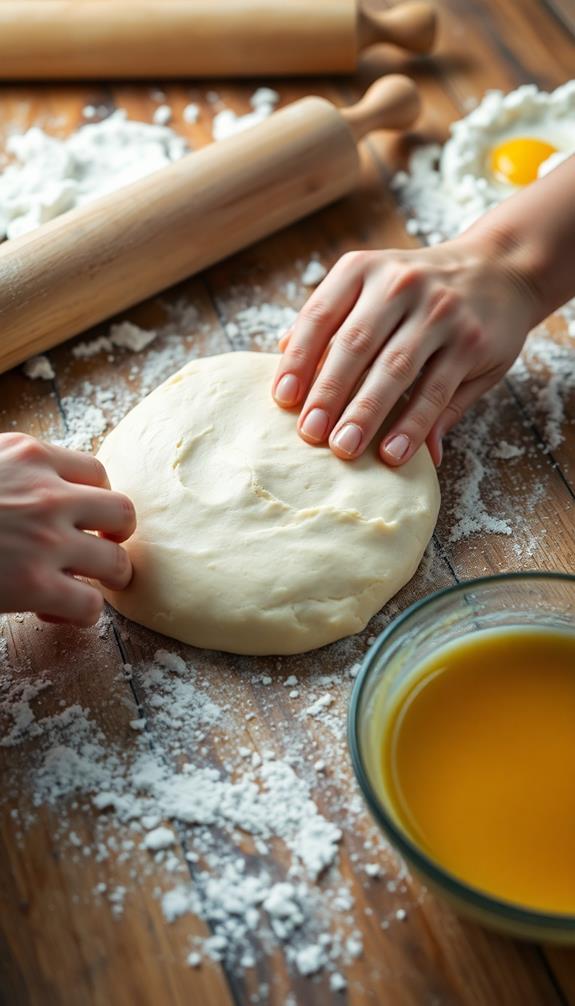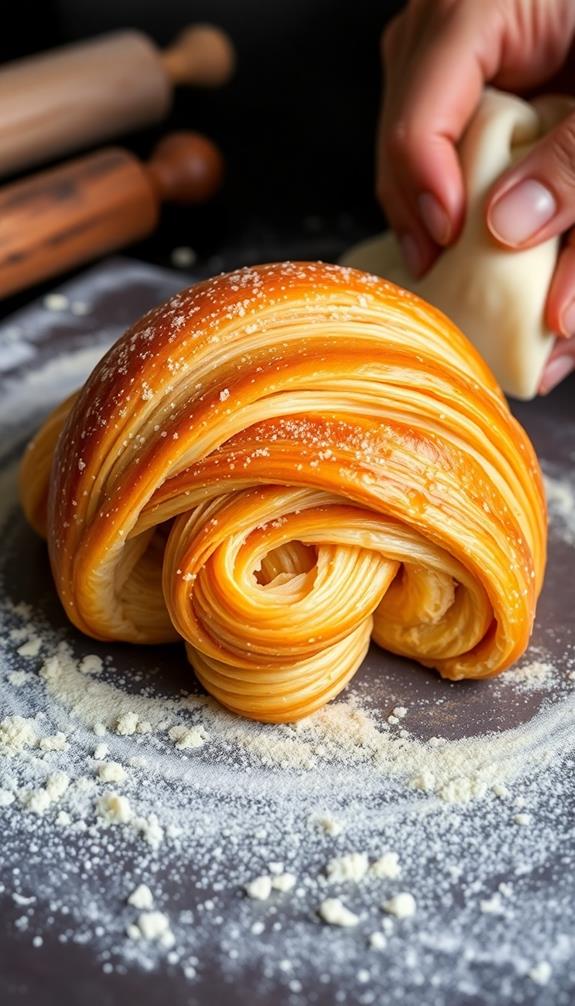You'll fall in love with crafting twisted croissants, a creative pastry that adds flair to your baking. Start by mixing warm water, yeast, and sugar, then incorporate all-purpose flour and salt until you have a slightly sticky dough. Allow it to rise until doubled. Next, prepare a butter packet and fold it within the dough, chilling between folds for flaky layers. Shape your croissants by cutting triangles, rolling them up, and twisting for that unique look. Bake until golden and enjoy the delightful texture. Keep going, and you'll uncover more tips for perfecting this tasty treat!
Overview of Twisted Croissants
Twisted croissants are often a delightful twist on the classic recipe, combining the flaky texture you love with an eye-catching shape. This creative variation takes the traditional croissant and adds a fun twisting technique, enhancing both its appearance and texture.
The process involves layering dough and butter to create those irresistible flaky layers, similar to the techniques used in making choux pastry, which also emphasizes the significance of proper mixing and lamination. You'll fold the dough multiple times, mirroring the lamination used in classic recipes to achieve that perfect flakiness.
One of the best parts about twisted croissants is their versatility. You can fill them with a variety of ingredients, like rich chocolate or sweet cinnamon sugar, to create delightful flavor combinations that suit your taste.
Once you've shaped your twisted croissants, let them rise in the refrigerator. This step is essential for maintaining the integrity of the butter, ensuring your final product turns out light and flaky.
When baked, these pastries develop a beautifully crispy exterior that contrasts wonderfully with their soft, fluffy interior. They emerge from the oven golden brown and ready to be enjoyed fresh.
Whether for breakfast or a special treat, twisted croissants are sure to impress.
Essential Ingredients Needed
To make twisted croissants, you'll need some essential ingredients that form the backbone of your dough. Key items like all-purpose flour, unsalted butter, and active dry yeast play vital roles in creating that perfect flaky texture and rise.
Additionally, incorporating a pinch of salt and a bit of sugar can enhance the flavor of your pastries. If you're missing any ingredients, don't worry—there are substitutions you can consider to still achieve delicious results, such as using gluten-free flour alternatives for a different texture.
Split any long paragraphs in the TEXT into separate paragraphs. Write the entire TEXT again, but with any long paragraphs split.
Retain any and all special formatting (e.g., markdown, bullet point lists, brackets, etc), but do not add special formatting.
Key Ingredients Overview
When preparing to make Twisted Croissants, you'll need a handful of vital ingredients that work together to create that perfect flaky texture.
First and foremost, you'll want to get your hands on unsalted butter. This type of butter is preferred because it lets you control the salt content while contributing to the croissant's delightful flakiness.
You'll also need all-purpose flour, with a total of 4 cups required to guarantee the dough achieves the right consistency for both lamination and rising.
Next, don't forget about active dry yeast—about 2 1/4 teaspoons is essential for fermentation and helps the dough rise, giving you that airy structure you desire.
For activating the yeast, warm water is important. Aim for a temperature between 105°F and 110°F to promote a successful dough rise.
Finally, a little sugar and salt round out the flavor profile, enhancing your croissants.
Once you've mixed these ingredients and allowed the dough to rise, you'll notice how beautifully it expands, setting the stage for your delicious Twisted Croissants.
Enjoy the process; it's all about those key ingredients working together!
Ingredient Substitutions Options
Making Twisted Croissants doesn't have to be intimidating, especially if you find yourself missing an essential ingredient. There are plenty of substitutions you can make to guarantee your recipe still shines. Here are some options to take into account:
- Flour: Swap all-purpose flour for bread flour for a chewier texture.
- Butter: If you're out of unsalted butter, use salted butter but cut down on the added salt.
- Yeast: Replace active dry yeast with instant yeast at a 1:1 ratio for a quicker rise.
- Dairy-Free: For a dairy-free option, try plant-based butter, though it might slightly change the taste and texture.
- Sugar: Reduce sugar for a lower-sugar option; just know it may affect browning and flavor.
These substitutions allow you to adapt the twisted croissant recipe to your pantry and dietary needs without sacrificing quality.
Whether you're trying to avoid dairy or simply don't have the right flour, you can still create delicious, flaky pastries that impress. Enjoy your baking adventure!
Preparing the Dough

Preparing the dough for your twisted croissants is an essential step that sets the foundation for their flaky texture. Start by combining water, yeast, and sugar in a stand mixer. Let it sit for 2-3 minutes until it gets foamy, which means the yeast is active.
Next, add salt and flour to the yeast mixture and mix until you have a soft, slightly sticky dough that clears the sides of the bowl without over-flouring. This dough-making process is reminiscent of creating the perfect base for a rich dessert like Hungarian Dobos Torte, which also relies on carefully prepared layers.
Knead the dough for 3-4 minutes until it's smooth, then cover it and let the dough rise until it doubles in size, which typically takes about an hour. You want the dough to remain soft and slightly sticky—this is vital for creating the delicious layers in your croissants.
While the dough rises, make sure your workspace is ready so you can work quickly. This is vital to prevent the butter from softening during the folding process.
After it has risen, you'll be set to move on to the next step, where you'll combine it with the butter block that's been refrigerated, setting the stage for those irresistible twisted croissants!
Crafting the Butter Packet
To craft the butter packet, you'll want to start with the right size of parchment paper, about 16 1/4 x 12 inches.
Incorporating healthier fats, such as avocado oil, can enhance the flavor and support overall well-being in your pastries.
Fold the edges to create a pocket for the butter, and remember to keep the butter cool to guarantee it rolls out evenly.
This careful preparation is key to achieving those flaky layers in your twisted croissant.
Butter Folding Technique
Creating a butter packet is vital for achieving the flaky layers in your twisted croissant. To master this technique, you'll want to follow these steps closely:
- Start with a piece of parchment paper measuring 16 1/4 x 12 inches.
- Fold the short edges inward about 4 1/2 inches for structure.
- Fold the top and bottom edges over about 1 3/4 inches.
- Place two sticks of cool butter in the center.
- Roll the butter inside the parchment into a thin, even sheet.
Now that you have your butter packet, you're ready to fold it into the dough. Roll your dough into a rectangle, about 18 x 11-12 inches.
Place the butter in the center, making sure it's face down. Next, fold the dough over the butter, sealing it completely. This step is essential—properly sealing the butter prevents leaks and guarantees your layers remain distinct and flaky.
With each fold you make, you'll create those delightful thin layers of dough that will elevate your croissant. Remember, it's all about the series of folds that will give your pastry its signature texture.
Happy baking!
Parchment Paper Sizing
Mastering the butter folding technique sets you up for success, but the right parchment paper sizing is equally important for crafting the butter packet. Start by cutting a piece of parchment paper measuring approximately 16 1/4 x 12 inches. This size will give you enough room to work with the butter effectively.
Next, fold the short edges of the parchment paper inward about 4 1/2 inches. Make sure to crease the folds well to create a secure packet. This step is vital for keeping everything contained during the rolling process.
After that, fold the top and bottom edges over about 1 3/4 inches to encase the butter properly.
Now it's time to add the butter. Place two sticks of cool butter in the center of the folded parchment. Carefully roll the parchment into a thin sheet, ensuring an even thickness throughout.
This careful preparation of the butter packet is essential for achieving the layers and flaky texture characteristic of croissant dough. With the right parchment paper sizing, you're setting yourself up for a beautifully layered pastry.
Importance of Chilling
Chilling the butter packet is vital for achieving the flaky layers that define twisted croissants. When you keep your butter cold, it maintains its firmness, which is essential for proper lamination.
Here's why chilling matters:
- It prevents butter from melting into the dough.
- A well-prepared butter packet should be pliable but cool.
- Keeping everything cold during rolling and folding is key.
- Refrigerating the dough after each fold helps solidify the fat.
- This guarantees the distinct flaky layers you crave.
After preparing your butter packet, remember to chill for another hour or so if it starts to soften. Ideally, you want to refrigerate overnight for best results.
The process of rolling and folding the dough while keeping both components chilled allows for even distribution, creating those coveted layers. If the butter seeps out, you'll lose that structure, and your croissants won't rise as beautifully.
Dough Folding Techniques

Folding the dough properly is essential for achieving that perfect flaky texture in twisted croissants. The key to mastering this lies in the dough folding technique you choose. Start by rolling the dough into a rectangle and enclosing a butter packet inside, similar to how Ruth Graves Wakefield introduced the chocolate chip cookie, ensuring even distribution of butter, which is vital for creating those flaky layers.
This technique not only enhances the texture but also mirrors the innovative spirit found in the history of chocolate chip cookies, where a happy accident led to a beloved treat.
You can use the single fold method, where you fold the dough into thirds like a letter. This technique is fundamental for building a base of flaky texture. Alternatively, the double fold, which resembles closing double doors, is another significant method that adds even more layers and contributes to the overall puffiness of your pastry.
Remember to chill the dough between folds. This step helps maintain the integrity of the butter, preventing it from melting and ensuring better lamination.
Each fold should be performed gently to avoid overworking the dough, which can lead to tough pastries instead of the desired light and flaky texture. By mastering these folding techniques, you'll be well on your way to baking twisted croissants that are as delicious as they're beautiful.
Shaping the Twisted Croissants
To shape your twisted croissants, start by cutting the rolled dough into triangles for easy handling.
The creation of these flaky pastries is rooted in the art of laminated dough techniques, which contribute to their buttery layers and irresistible texture.
Roll each triangle to create a tight spiral, then twist them to form that signature shape.
Don't forget to pinch the ends together to keep everything in place as they rise and bake.
Cutting Dough Triangles
Shaping twisted croissants begins with rolling your laminated dough into a 12-13 inch square, ensuring it's evenly thick for consistent baking.
Now it's time to cut the dough into triangles for rolling. Follow these steps for perfect results:
- Cut the square into four strips, each about 3 inches wide.
- Each strip should yield triangles with a base of around 5 inches.
- This size is essential for achieving a proper roll-up, creating that classic croissant shape.
As you roll each triangle from the base to the tip, gently stretch the dough. This enhances the layers and results in a beautiful twist.
After shaping your twisted croissants, place them on a parchment-lined baking sheet.
Don't rush this process! The way you cut the dough and roll each triangle directly impacts the final texture and appearance of your pastries.
Allow the twisted croissants to rise until doubled in size, which will give them that light and airy texture we all love.
With each step, you're getting closer to a delicious treat that's both visually appealing and scrumptious! Happy baking!
Rolling and Shaping
Achieving perfectly twisted croissants starts with cutting your rolled dough into four strips, each about 2-3 inches wide.
With a rolling pin, make certain the dough is even before you slice it. Now, grab one end of each strip and twist it several times to create that delightful spiral effect.
Place the twisted strips on a parchment-lined baking sheet, making sure to space them adequately. This distance allows for rising without sticking together.
After shaping the twisted croissants, let them rest for about 30-45 minutes. This rising time is essential, as it makes your croissants noticeably puffy and gives them that airy texture.
While you wait, preheat your oven so it's hot and ready when your croissants are done rising.
Before you slide them into the oven, don't forget to brush with melted butter. This step not only enhances the flavor but also guarantees your croissants develop a beautiful golden brown crust.
With these steps, you're well on your way to enjoying your delicious twisted croissants, perfect for any occasion!
Rising and Proofing

Rising and proofing are essential steps in making twisted croissants, as they guarantee your dough develops the right texture and flavor. During rising, the dough ferments and expands, typically doubling in size within an hour in a warm environment.
However, opting for a slow rise in the refrigerator prevents the butter from melting, enhancing the lamination and resulting in a superior flaky pastry. Achieving flakiness in crusts can also be applied to your croissant dough for the best results.
Here are some key points to take into account:
- Monitor the dough closely during rising and proofing.
- Proper proofing allows yeast to create air pockets for a light texture.
- Cover the twisted loaves while proofing for best results.
- Place the loaves on a parchment-lined half sheet pan.
- Look for a visibly puffy appearance to indicate readiness.
Getting the rising and proofing just right is vital. Temperature and humidity can greatly impact your dough's development, so keep an eye on these factors as you work.
With patience and attention to detail, you'll create a beautifully flaky twisted croissant that's a joy to bake and even more delightful to eat.
Baking Instructions
Baking your twisted croissants is where all your hard work pays off, transforming the carefully crafted dough into a beautifully golden pastry.
Start by combining water, yeast, and sugar in your stand mixer, letting it sit for 2-3 minutes until it's foamy. This step is vital as it activates the yeast, ensuring your dough will rise properly. Then, add salt and flour to form a soft, slightly sticky dough.
Next, roll the dough into a rectangle (about 18 x 11-12 inches) and place your prepared butter packet in the center. Folding the dough over the butter, sealing it well is essential for achieving those flaky layers reminiscent of a well-made Prinsesstrta.
After that, roll the dough into a long rectangle (about 8 x 22 inches), fold each short edge into the center, and then in half to create layers. Roll it into a 12-13 inch square, cut it into four strips, and twist each strip to create the iconic croissant shape.
Place the twisted loaves on a parchment-lined baking sheet and let them rise until they appear noticeably puffy.
Tips for Perfect Results

To guarantee your twisted croissants turn out perfectly, focus on maintaining a slightly sticky dough during preparation. This texture is essential for achieving the soft, smooth layers you desire. Here are some tips to help you achieve perfect results:
- Make sure to knead the dough just until combined; over-kneading can make it tough.
- If the dough is too sticky, sprinkle a little flour on your work surface, but don't overdo it.
- Wrap the dough tightly in plastic wrap to prevent it from drying out during resting.
- Allow your twisted loaves to rise in the refrigerator for a slow, controlled rise; this keeps the butter firm for better lamination.
- Bake the croissants at 375°F for a golden crust, but if you prefer a deeper color, increase the temperature to 400°F for the last few minutes.
Once baked, brush your warm twisted croissants with melted butter from the baking sheet. This adds that extra layer of flavor and richness that will make them irresistible.
Follow these tips, and you'll enjoy beautifully flaky and delicious twisted croissants every time!
Storage and Serving Suggestions
Store your twisted croissants in a Ziploc bag at room temperature for up to 2-3 days to keep them fresh and flaky. If you want to enjoy them later, you can freeze them. Just be sure to thaw them completely before warming them in the oven for the best texture. This method restores that delightful flakiness you love.
When it comes to serving, twisted croissants shine at breakfast, brunch, or as a snack. Enjoy them fresh out of the oven, or serve them at room temperature for a more casual presentation.
For an extra touch of flavor, brush the warm croissants with melted butter right before serving. This simple addition enhances their rich, buttery goodness and makes each bite even more indulgent.
Pair your twisted croissants with coffee, tea, or hot chocolate for a truly delightful experience. The combination of a hot beverage and a flaky pastry creates a comforting moment you won't forget.
Embrace the versatility of these croissants, whether you savor them alone or share them with friends and family—each bite is sure to impress!
Conclusion
To sum up, baking twisted croissants is like orchestrating a beautiful symphony; each step harmonizes to create a delightful pastry. With the right ingredients, techniques, and a bit of patience, you'll achieve flaky, golden perfection that'll impress anyone who takes a bite. Remember to enjoy the process and experiment with flavors. Once you've mastered this recipe, you'll never look at traditional croissants the same way again. So, roll up your sleeves and get baking!





